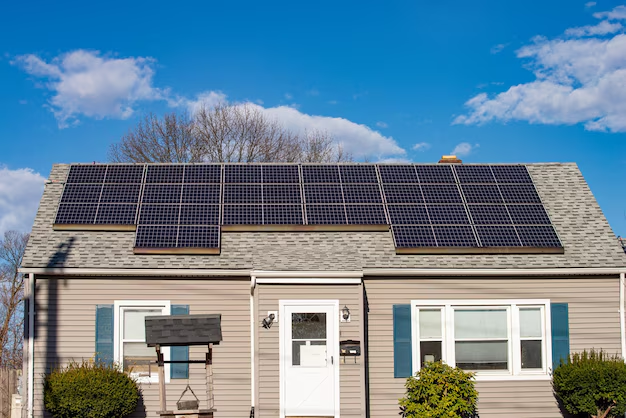Harnessing the Sun: How Many Solar Panels Are Needed to Power Your Refrigerator?
As the world moves towards more sustainable energy solutions, many homeowners are embracing solar power to reduce their carbon footprint and cut electricity costs. One common question that arises in this transition is: How many solar panels do you need to run a refrigerator? This question might seem straightforward, but various factors influence the answer, making it essential to explore these aspects in detail.
Understanding Your Refrigerator's Energy Needs
How Much Power Does Your Refrigerator Consume?
Refrigerators are among the most energy-intensive appliances in any home, constantly running to keep your food fresh. The energy consumption of a refrigerator depends on several factors, including its size, age, model, and efficiency rating. Typically, a modern refrigerator can use anywhere from 100 to 800 watts per day.
For a more precise estimate, check the refrigerator's energy rating label, usually found inside the door or in the user manual. This label provides an annual energy consumption figure, measured in kilowatt-hours (kWh).
Calculating Daily Energy Usage
To determine how much energy your refrigerator uses daily, divide the annual kWh figure by 365 days. For example, if the refrigerator label lists 300 kWh annually:
- Daily Usage = 300 kWh / 365 ≈ 0.82 kWh per day
🔌 Quick Tip: Energy usage might increase if the door is frequently opened or the appliance is placed in a warm area.
Solar Panel Basics: How They Work
What Is a Solar Panel?
A solar panel comprises photovoltaic (PV) cells that convert sunlight directly into electricity. These panels come in various sizes and capacities, typically rated in terms of wattage, which indicates the maximum power output under standard conditions.
How to Match Solar Panel Output to Appliance Needs
Once you know your refrigerator's energy consumption, you can determine the number of solar panels needed. However, this involves understanding the panel's wattage output and the average number of peak sunlight hours in your location.
🔆 Important Note: Peak sunlight hours aren't the total daylight hours but the optimal sunlight conditions for panels to produce the most energy.
Estimating the Number of Solar Panels
Calculating Required Solar Output
Imagine you have a refrigerator with a daily energy demand of 0.82 kWh, and you experience about 4 peak sunlight hours per day:
Determine Daily Solar Energy Production Needed:
- Convert the daily kWh requirement to the equivalent watt-hours: 0.82 kWh * 1,000 = 820 watt-hours.
Calculate the Solar Output Needed per Hour:
- Required hourly output = 820 watt-hours / 4 peak hours ≈ 205 watts
Selecting the Right Solar Panels
If each solar panel has a capacity of around 250 watts, you'd need approximately one panel to meet the refrigerator's daily needs under optimal conditions. However, practical conditions like overcast weather or shade may necessitate more panels to ensure consistent energy supply.
💡 Pro Tip: Consider adding an extra panel to account for such fluctuations and ensure reliability during less favorable days.
Integrating Solar with Your Home
The Importance of a Solar Battery System
While solar panels gather energy during the day, refrigerators need a continuous power supply, including at night. Hence, incorporating a solar battery system becomes crucial. This allows you to store excess energy produced during the day for use when sunlight isn't available.
Choosing the Right Inverter
Solar inverters convert the DC electricity generated by panels into AC electricity, compatible with home appliances. Ensure the inverter's capacity exceeds your refrigerator's peak wattage to handle the load efficiently.
🛠️ Installation Insight: Consulting a professional for proper sizing and installation ensures safety and efficiency in your solar setup.
Practical Considerations and Next Steps
Factors Affecting Solar Efficiency
- Geographical Location: Sunlight availability varies greatly depending on geographical location. Areas closer to the equator generally receive more sunlight, aiding solar efficiency.
- Seasonal Variations: Seasonal changes affect the duration and intensity of sunlight.
- Panel Positioning: To maximize efficiency, panels should face the sun directly and be free from obstructions like trees or buildings.
Exploring Financial Incentives
Solar installations can be costly. However, several financial incentives, tax credits, and rebates can help offset these costs, making solar adoption more affordable.
Summary: Solar Panel Checklist 📝
To run a refrigerator on solar power, consider the following:
- 🔍 Identify Refrigerator Energy Needs: Determine your daily kWh requirement.
- ☀️ Estimate Sunlight Availability: Factor in your local peak sunlight hours.
- 🔋 Select Adequate Solar Panels: Purchase panels that match your energy needs, considering an additional buffer.
- ⚡ Invest in a Battery System: Essential for night-time and cloudy days.
- 🧰 Choose a Suitable Inverter: Ensure it aligns with your appliance needs.
- 💵 Research Financial Aid: Look for rebates and incentives to ease the investment.
Transitioning to solar power involves initial planning but offers long-term benefits, from energy savings to environmental sustainability. With the correct setup, not only can you power your refrigerator, but you can also start exploring solar energy solutions for your entire home. Embrace the sun and enjoy an energy-efficient lifestyle!
